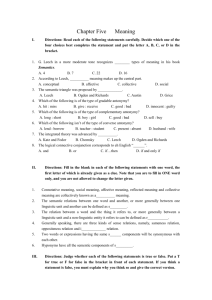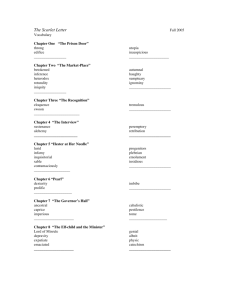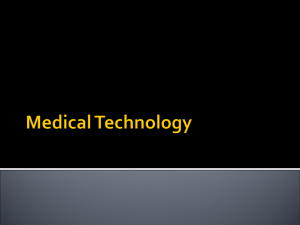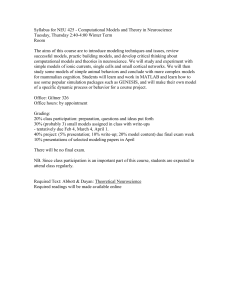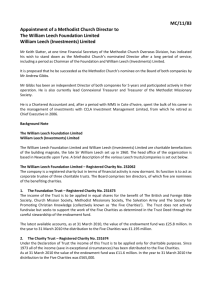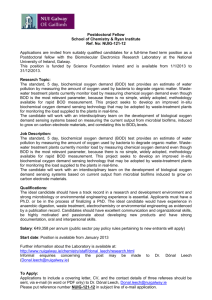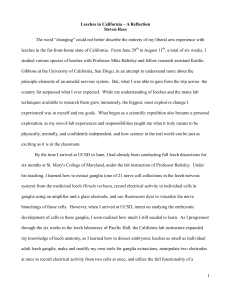Hirudo Medicinalis Local Bending: INTRODUCTION
advertisement
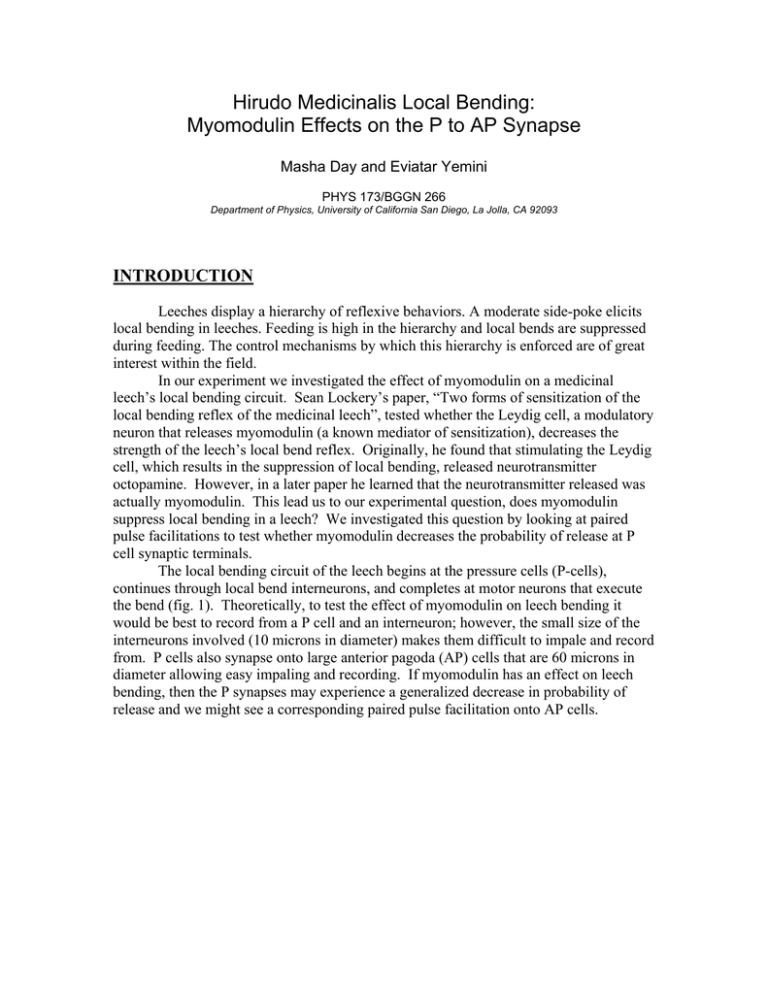
Hirudo Medicinalis Local Bending: Myomodulin Effects on the P to AP Synapse Masha Day and Eviatar Yemini PHYS 173/BGGN 266 Department of Physics, University of California San Diego, La Jolla, CA 92093 INTRODUCTION Leeches display a hierarchy of reflexive behaviors. A moderate side-poke elicits local bending in leeches. Feeding is high in the hierarchy and local bends are suppressed during feeding. The control mechanisms by which this hierarchy is enforced are of great interest within the field. In our experiment we investigated the effect of myomodulin on a medicinal leech’s local bending circuit. Sean Lockery’s paper, “Two forms of sensitization of the local bending reflex of the medicinal leech”, tested whether the Leydig cell, a modulatory neuron that releases myomodulin (a known mediator of sensitization), decreases the strength of the leech’s local bend reflex. Originally, he found that stimulating the Leydig cell, which results in the suppression of local bending, released neurotransmitter octopamine. However, in a later paper he learned that the neurotransmitter released was actually myomodulin. This lead us to our experimental question, does myomodulin suppress local bending in a leech? We investigated this question by looking at paired pulse facilitations to test whether myomodulin decreases the probability of release at P cell synaptic terminals. The local bending circuit of the leech begins at the pressure cells (P-cells), continues through local bend interneurons, and completes at motor neurons that execute the bend (fig. 1). Theoretically, to test the effect of myomodulin on leech bending it would be best to record from a P cell and an interneuron; however, the small size of the interneurons involved (10 microns in diameter) makes them difficult to impale and record from. P cells also synapse onto large anterior pagoda (AP) cells that are 60 microns in diameter allowing easy impaling and recording. If myomodulin has an effect on leech bending, then the P synapses may experience a generalized decrease in probability of release and we might see a corresponding paired pulse facilitation onto AP cells. SKIN Pv LBI LBI LBI Pd LBI LBI Pv LBI LBI iMN d iMN v iMN v iMN d eMN v eMN d eMN d eMN v LBI LONG ITUDI NAL MUSC LES LBI Pd Fig. 1 The Leech Local Bend Circuit THEORY The theory of action potentials, on which our experiment is partially based, rests on the Hodgkin-Huxley model. This model uses a set of non-linear ordinary differential equation to approximate the electrical characteristics of neurons. Originally created to describe the ionic mechanisms of initiation and propagation of action potentials in a squid giant axon, it works perfectly to describe the spiking dynamics of other neurons; in our case, the leech P and AP cells. The model accounts for action potentials of a neuron by a triggered rapid inward current of Na+ ions followed by a slower activated outwards current of K+ ions. The currents result from independent permeability mechanism for Na+ and K+ whose conductance changes as a function of time and membrane potential. The flow of the ions are independent mechanisms, thus voltage gated ion channels and leak currents are physiologically responsible for the action potential. The model successfully creates an electrical analog for each component of the excitable cell by statistically determining when channels open and close. 1 The formula for the three membrane currents is given below: Ik = gNa m3h (u - ENa) + gK n4 (u - EK) + gL (u - EL). The leak channel is described by a voltage independent conductance, gL = 1/R, however the conductance of the other ion channels is voltage and time dependent. When the channels are all open, currents are transmitted with maximum conductance, gNa and gK. Their probability of being open is described by variables, m,n, and h. M and H controls the Na+ channels, while K+ are controlled by N. Ena, Ek, and El are reversal potentials, whose values are derived from the Nernst equation and based on the ionic concentrations inside and outside the cell. 1 The theory is applicable to a wide range of neuronal responses including spiking and EPSP, which we observe in the experiment. The P and AP cells in the leech, from which we recorded, are easily accessible for intracellular recording. The medicinal leech has a simple, well studied nervous system as well as very large distinct nerve signatures that accompany its behaviors (swimming, feeding, etc.). These make it an ideal animal for physiological research. A central nerve cord connects 21 separate ganglia in addition to a head and tail brain (fig. 2). Each ganglion contains approximately 350 neurons (fig. 3), of which 4 are pressure (P cells) and 4 are AP cells. 3 Fig. 2: Leech Neuroanatomy A central nerve cord connects 21 separate ganglia in addition to a head and tail brain. Fig. 3: Ganglion Each ganglion contains approximately 350 cell bodies. Leeches respond to a moderate poke in the side with a reflexive bend, localized in the area of applied pressure. However local bending has been to be suppressed in the presence of myomodulin. 2 Myomodulin, a peptide, has been shown to play an important role in the modulation of the properties of leech muscles and neurons that are associated with specific behaviors such as feeding and locomotion. Myomodulin is present in neurons that modulate neuromuscular transmission. Pressure (P) and Leydig cells as well as their coupling interneurons are immunoreactive for myomodulin. 5 To test the effect of myomodulin on local bending we used paired-pulse facilitation (PPF) to search for a decrease in the probability of release at the synapse from P onto AP. To test PPF a P cell is given a train of 2 stimulations (fig. 4) resulting in spikes and the resulting EPSP responses in the AP cell are recorded. A decrease in the probability of release corresponds to less vesicles being released when a spike arrives and results in a smaller recorded EPSP. When the second spike arrives with sufficiently small delay, residual calcium ions left over from the first spike combine with the new calcium influx to create a larger second EPSP (fig. 5). We calculate the paired-pulse ratio, defined as EPSP2/EPSP1. When the ratio has a value greater than 1 it indicates facilitation and, correspondingly, a decrease in the probability of release of vesicles at the synapse.4 Fig. 4 A train of two pulses delivered to the P cell. Fig. 5 Paired pulse facilitation. The second EPSP is larger than the first due to residual calcium ions left over in the presynaptic terminal from the first spike. EXPERIMENT SURGERY The leeches that were used for this experiment were obtained from Kristan lab, and were transported in small jars containing leech saline. Prior to surgery the jar was placed on ice for 5 minutes to sedate the leech. To extract a ganglion the leech’s foot was pinned onto wax of the dissection tray with a 21 G injection needle. The dissection tray consists of a hollow base which is filled with ice and a recessed base lined with wax and filled with leech saline, on which the surgery takes place. A second 21G needle was used to pin down the head after which the leech was stretched. Once stretched to proper tension it was pinned dorsal side up, revealing a pair of longitudinal orange bands. An initial incision was made through the middle of the body through the skin and muscle. The skin was stretched out and pinned away from the body with 25G pins, revealing the stomach cavity. Using a vacuum, blood ingested by the leech was sucked out revealing the lining of the gut and connective tissue with had to be cut away to finally reveal the nerve cord and ganglia. The nerve cord and ganglia are encased in a green “stocking” of vascular tissue and nerves. The connective was cut anterior and posterior to the desired ganglion. Then the stocking was cut longitudinally, over and under the ganglion. The final step was to cut away and free the ganglion at its lateral nerves. Once free the ganglion was placed in a Petri dish containing silguard using a pipette. The ganglion was pinned out using pins that were made of 0.002mm tungsten wire. The connective was pinned down first followed by the stocking to ensure the ganglion was pined taught. Cold leech saline was continuously added to the dish to ensure the cells stayed alive. Leech saline was made in advance and stored in the fridge at 20C. The solution is made of the following ingredients, with a pH of 7.4: SETUP The electrophysiological rig used during our experiment consisted of: a vibration resistant table, two electrode clamps controlled by right and left handed micromanipulators, a microscope, microscope lamp, a two channel oscilloscope, differential preamplifiers, a perfusion setup to switch leech saline with myomodulin, and a computer equipped with lab view. The sample field condenser is a ring of 12 LED’s that focus light into a hollow cone, in order to avoid direct transmission of light into the microscope. The ganglion prep from which the recordings are made sits on top of a 1/8” plastic platform that rests on a floating breadboard which acts to eliminate vibrations. The Petri dish has a ground wire placed directly into the solution to ground the sample. The cone of light scatters light to illuminate the tissue while maintaining clear optics. Two electrode holders rest on either side of the scope on the air table. They could be coarsely manipulated in the x, y, and z planes. Hydraulic manipulators could be employed for finer manipulation, but only in the x plane. Intracellular recording are made with glass microelectrodes. We used 1.5mm diameter borosilicate glass capillaries to make electrodes. Through trial and error we created a program that pulled electrodes with a gradual taper, between 5mm – 10mm, with a resistance in the range of 50-80 milliohm. The electrodes were filled with solution using an electrode back filler. The electrode used for piercing the P cell was filled with 240mM potassium glucanate, a low electrolyte concentration solution. The electrode used for the AP cell was filled with 1M potassium acetate + 20 mM KCL. The higher concentration of electrolytes, although worse for the life of the cell, allows for better recording. Electrodes fit onto the electrode holder via a bleach-treated platinum wire. The wire is pre-coated with Cl- to allow a better transmission medium for current. The signal from the electrode is passed to the oscilloscope through a 10X amplification. The electrode tip was gently placed into the leech saline which gave out a small voltage reading. Although the rig was grounded, there was a small potential that was corrected to zero on the amplifier. To test the resistance of the electrode a 1 nA current was passed through. The resulting potentials were no more than 80 ohms. The resistance of the electrode was compensated by again passing a 1nA current and zeroing the resistance compensation of the amplifier. This accounts and compensates for the electrode’s intrinsic resistance. If the initial resistance of the electrode is over 100 it is very hard to compensate so, in these cases, we pulled a new electrode. Impaling a cell requires good visibility, sharp electrodes, as well as practice. The best way to impale a cell is to position the top of the electrode above the center of the cell with just enough pressure that the cell begins to dimple and the circumference of the cell begins to expand. We gently tap the micromanipulator on the adjustment knob. The tap is enough movement to push the tip of the electrode through the ganglion sheath and cell membrane. At this point we observe the oscilloscope rather than the microscope. Once the electrode is inside the cell the resting potential on the oscilloscope drops to -60mV and cell activity is seen. Care must be taken not to break the tip of the electrode by advancing it too far so that it comes in contact with the silguard or brush it against a pin. It is also important to check that the impaled cell is viable. This can be done by observing several factors: a viable cell should exhibit a normal resting potential and spontaneous action potentials for some neurons or responses to depolarization and/or hyperpolarization for others. Another parameter is a stable membrane resistance, if the resistance fluctuates while the cell is impaled it is not viable. Membrane resistance is checked by “buzzing” the cell with a current of 1 nA. A change in membrane potential should be between 10-75 MOhms. “Buzzing” the cell should result in a change in the rate of action potentials. When a positive current is injected the spike rate should increase whereas when a negative current is injected the spike rate should be suppressed. If no change in activity is exhibited when the cell is buzzed than the cell is not viable or not properly impaled. 3 We practiced impaling on large retzius cells and then progressed to the P and AP cells. We used a ganglion map (fig. 6) and the fact that each cell has distinct responses in order to locate specific cells. The response of the P cell, is very specialized and easily detectable, it exhibits spontaneous and continuous 65mV spikes. The AP cell also has a very distinct firing pattern that is easily identified; it tonically fires 5-10mV spikes. Fig. 6 Leech Ganglion Map. The red cells are the P Cells and the blue cells are AP cells. The prep for our experiment was rather simple. After dissecting the leech and removing a ganglion (fig. 7), we pinned it in a recording chamber. Once the location and identity of the P cell was found it was impaled with a glass electrode. Next we located and identified the AP cell that was also impaled with a glass electrode. We hyperpolarized the AP cell with 0.5 nA current in an attempt to curb spiking. We used proprietary software, programmed to deliver two pulses and record the resulting EPSPs (the paired pulse protocol). A perfusion setup (fig. 8) was used to first deliver leech saline and then 100uM myomodulin. We ran the experiment for 600 seconds. At first the solution in the recording chamber was leech saline, at 200 seconds it was perfused with myomodulin. Matlab was used to analyze and organize the data. Fig 7 Leech dissection to remove a ganglion. Fig 8 A perfusion setup to deliver leech saline followed by a 100uM solution of myomodulin. RESULTS In our experiment we tested whether the addition of myomodulin, through bath application, decreased the size of P-stimulated EPSPs in AP. We used a paired-pulse protocol to administer repeated trials, observe the resulting EPSPs, and calculate the paired-pulse facilitation ratio. Our results proved to be inconclusive because we were unable to calculate the PPF ratio due to the strength of P onto AP synapse. Although we hyperpolarized the AP cell with a 0.5nA to curb spiking, the second pulse delivered to the P cell inevitably resulted in an AP spike. What seemed to be paired-pulse facilitation (fig. 10), was instead a spike in the AP cell as a result of the second P spike. This is evidenced by a sharp, nearly vertical, rise in the slope of the second EPSP. The exponential fitting this rise, the immediate dip following the peak, and the value of the potential change all indicate a spike. In future experiments, we could try to use high divalent cations, like Mg2+, to screen the electrical charge across the membrane thus raising the threshold for firing an action potential. We could also play with the delay between spikes and the amount of hyperpolarizing current injected. By doing so we might be able to get a reading of the second EPSP to calculate a paired-pulse facilitation ratio. Fig 9. We ran the experiment for 600 seconds, at 200 seconds we added myomodulin. There appears to be no decrease in the EPSP amplitude after adding myomodulin although this data is confounded by postsynaptic spikes. Fig.10 Recording of the AP cell at top and P cell below. This looks like paired pulse facilitation in the AP because of the small first peak and much larger second peak. However the second peak is not an EPSP, it is an action potential resulting from the second pulse to the P cell Given the time, tools, and skills we would have looked at the paired pulse ratios directly, recording from the P cell and the local bend interneurons. However our equipment did not permit us to perform this experiment. It would also be interesting to test the effects of myomodulin on bending in a semi-intact prep. A potential follow-up experiment once the role of myomodulin is understood, could be to see whether myomodulin is responsible for suppressing local bending during feeding. This might aid in understanding the control mechanisms that enforce the hierarchy of leech behaviors. DIFFICULTIES ENCOUNTERED: Much of the lab time was spent trouble shooting the experimental set-up. To correct the problem of noise, every component of the rig was grounded, even the air table. Further noise elimination was implemented by building a Faraday cage. A Faraday cage was constructed out of 4 screens that were cut and assembled to the height and depth of the rig. The grounding and cage vastly improved the noise problem, reducing our noise to less than 2 mV. The electron puller did not pull consistent electrodes. Although the same program was used the resistance of the electrodes varied widely (potentially due to daily fluctuations in temperature and/or characteristics of the glass capillary tubes). Often our electrodes had to be re-pulled as their resistance was too high. The optics on the scope were not adequate to identify specific cells. The plastic platform on which the ganglion prep rested was reduced in thickness from ½” to 1/8”. Reducing the thickness brought the sample closer to the LED light source and greatly improved the optics, though still was not perfect. The LED light sources had to be continually replaced through the course of the experiment because individual bulbs would burn, necessitating the replacement of the unit. Brighter and more constant light would have also improved optics. REFERENCES 1. M. Häusser, “The Hodgkin-Huxley theory of the action potential,” Nature Neuroscience. 3, 1165 (2000). 2. S.R. Lockery, W.B. Kristan, “Two forms of sensitization of the local bendng reflex of the medicinal lech,” Journal of Comparative Physiology A. 168, 165-177 (1991). 3. Muller, Nicholls, and Stent, Neurobiology of the Leech. 4. J-H. Wang, P.T Kelly, “Attenuation of Paired Pulse Facilitation Associated with Synaptic Potentiation Mediated by Postsynaptic Mechanisms,” Journal of Neurophysiology 78, 2707-2716 (1991). 5. Y. Wang, J. Strong, and C. Sahley, “Modulatory Effects of Myomodulin on the Excitablity and Membrane Currents in Retzius Cells of the Leech.” Journal of Neurophysiology 82, 216-225 (1999)
